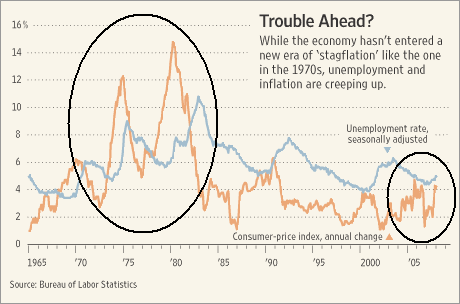First -- before anyone hits the panic button -- here is chart from the same story that compares the unemployment and inflation rate of the 1970s and now. Notice we are nowhere near the problem levels we saw in the 1970s.

Remember -- it takes a long time to change the levels of unemployment and inflation; the fed can't just turn them around next month. As a result, when economists take current conditions and extrapolate them out the possibility of stagflation increases.
First, the article notes that inflation is not behaving itself (where have I read that before?)
Sara Lee Corp. this week told analysts it expects to recoup rising raw-material costs in part by raising prices, especially on bread. Company spokesman John Harris said Sara Lee's significant competitors had matched the increases, with consumers showing no sign of trading down to lower-cost brands. "With commodities reaching unprecedented levels," Mr. Harris said, "it is quite likely we will take pricing up again."
Goodyear Tire & Rubber raised the price of replacement tires 7% on Feb. 1, on top of two increases totaling 11% last year. Chief Financial Officer Mark Schmitz told analysts last week that the hike was the result of rising prices of key raw materials, according to a transcript by Thomson Financial. Mohawk Industries Inc. raised carpet prices in December and again in January because of rising material costs, even though sales have been hurt by the slumping housing market.
The declining dollar, while boosting U.S. exports, is adding to inflation pressure, as goods priced in foreign currencies become relatively more expensive. Prices for imports from China jumped 0.8% in January, the largest monthly increase since the Labor Department began reporting the data in 2003.
Two other price increases come to mind while reading this. FedEx announced a rate increase awhile ago and the airlines added a "fuel surcharge" sometime in the last 6-9 months. For those of you who missed it, here is an article I wrote on inflation on Tuesday. Short version: there are a ton of reasons to be concerned.
However, on the employment picture I'm not sure we're going to get really high unemployment. According to the NBER the last recession ended in November 2001. However according to the BLS, employment growth really didn't start meaningfully increasing until 2003. According to the BLS's employment level information, there were 137,778,000 jobs in January 2001 and 137,417,000 in January 2003 -- a decrease of 361,000. By January 2004 the total jobs numbers were 138,463,000. So the job market was seriously lagging after the end of the latest recession.
I have a working theory about the job market this expansion. Employers really held back on hiring this time around. Instead of mass hiring, they really worked at increasing their overall productivity and used that instead of a massive round of hiring. When it became more and more obvious that they needed more employees, employers added as few as possible, instead relying on the increase in productivity combined with fewer employees.
As a result, we now have a lot of employers who are wedded to a high productivity/low labor input model. But this model uses a very high level of employee/productivity interaction. That means any loss of employees will lead to bigger losses in productivity and therefore bigger losses in profit.
As a result, employers can't start a massive round of layoffs. Cuts to the labor force will happen very slowing if at all. As a result, we're not going to see sky high unemployment this time around, although we will see an increase.